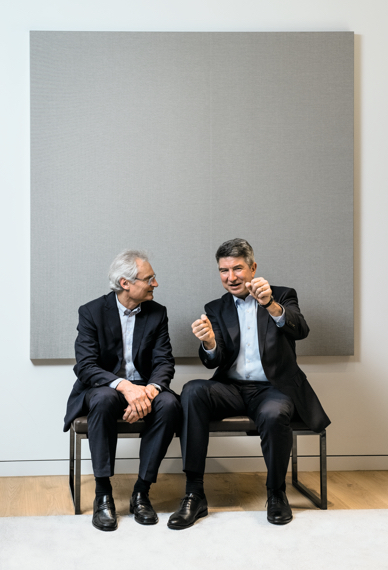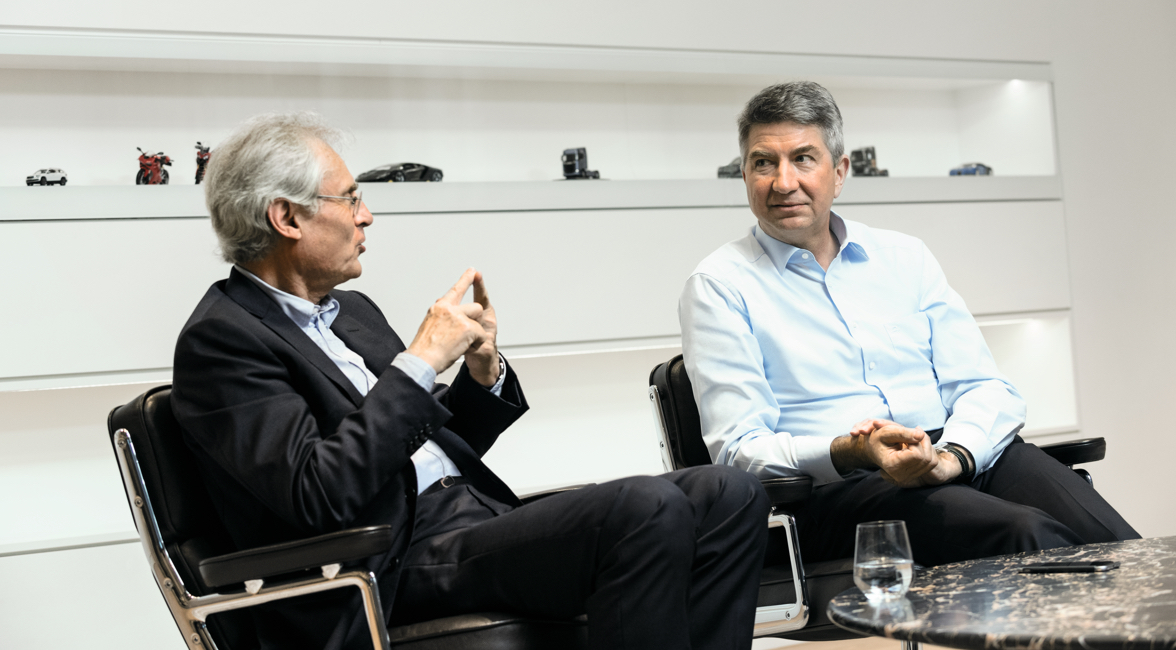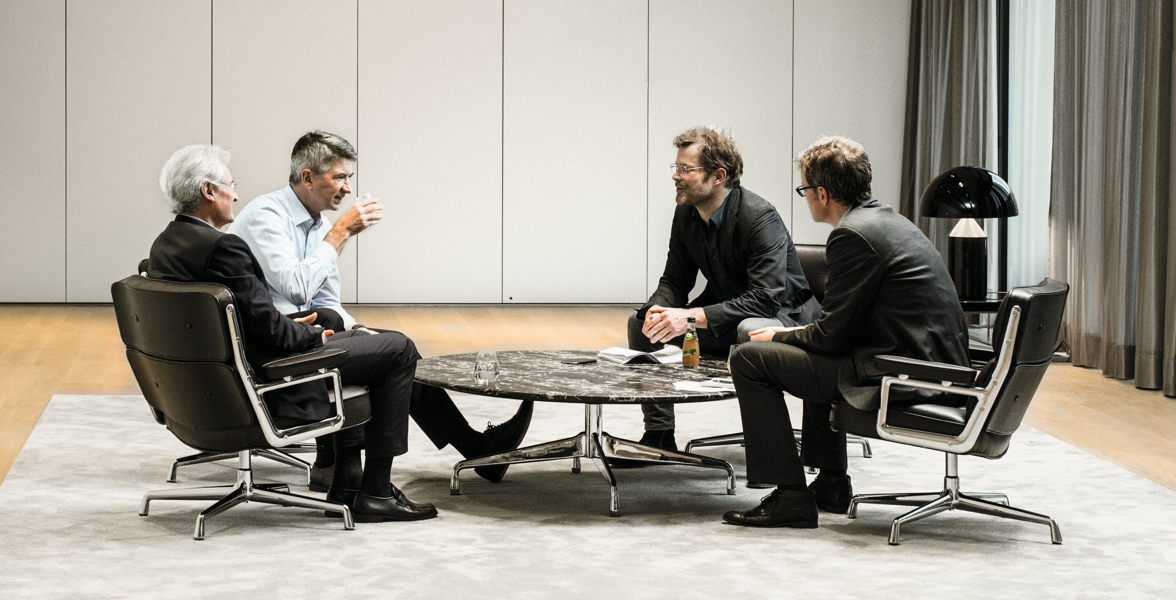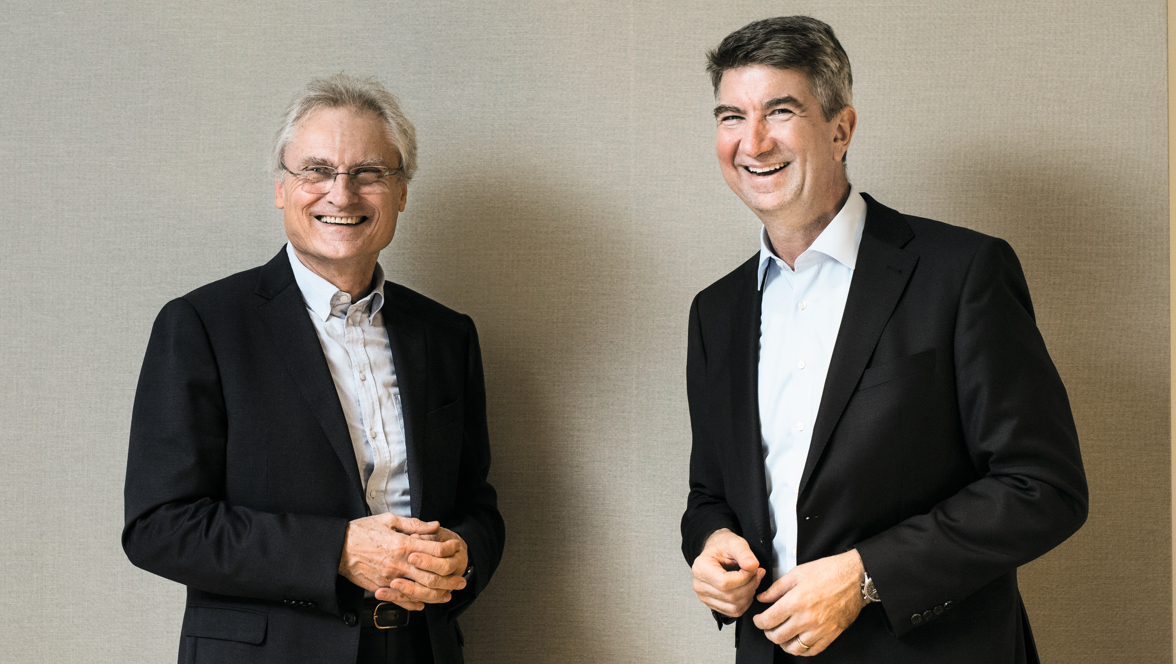The auto industry is facing the biggest transformation in its history. Ulrich Eichhorn and Henning Kagermann discuss the most pressing issues.
Where are e-mobility and CNG drives headed? How will today’s automakers become the mobility services providers of tomorrow? Will we still own cars ten years from now? And what can the Volkswagen Group learn from the software industry? When it comes to the top issues impacting future mobility, hardly anyone can match the expertise of the two gentlemen we are meeting this afternoon at DRIVE, the Volkswagen Group Forum in Berlin: Dr. Ulrich Eichhorn, Head of Research and Development at the Volkswagen Group, and Prof. Henning Kagermann, President of the Deutsche Akademie der Technikwissenschaften (National Academy of Science and Engineering (acatech)) and a leading thinker on mobility issues. They know each other from many expert discussions. They both hold science PhDs – one of them in mechanical engineering, the other in physics. And both value a frank and open exchange.
Mr. Eichhorn, people have been predicting the beginning of the electric era for years, but so far e-mobility still hasn’t become a mass market anywhere, not even in its heartland of China. When will this change?
EICHHORN My estimate is 2020. By then battery production will have become so cost-efficient that we will be able to offer EVs at affordable prices, and we will have a meaningful charging structure by then, too. In other words, the EVs we will be putting on sale from 2020 will have a range of up to 600 kilometers, and get an 80 percent charge in 15 to 20 minutes. And they will cost about the same as conventional drives. That does away with the three main reasons why customers are reluctant to buy electric: high price, low range and inadequate charging facilities.
“We’ll soon be able to produce synthetic natural gas from sustainable sources. So CNG vehicles will be carbon neutral.”
Dr. Ulrich Eichhorn, Head of Research and Development at the Volkswagen Group since 2016

To steer or not to steer? Ulrich Eichhorn (right) shows Henning Kagermann that self-driving can be fun, too.
When it comes to EV numbers, Norway and China are way ahead of the U.S. or Germany. What can we learn from these trailblazers?
KAGERMANN Market support from the governments in these countries is far more extensive. In Norway, EV drivers are allowed to use bus lanes and they have free public parking in cities. China uses an even more powerful instrument – vehicle registration. If you buy a car with an internal combustion engine in Shanghai you can often wait years to get your license plates. But if you buy an EV, you get them straight away. There are good reasons why we don’t use such methods. Nevertheless, things have changed quite a bit in Germany, too. Take the environmental incentive and the charging infrastructure program, for example. In global terms, though, other countries are much further ahead.
What is Volkswagen doing with regard to infrastructure?
EICHHORN Together with other manufacturers we have founded a pan-European high-power charging network called IONITY to build a network of fast charging stations along motorways and major routes in Europe. We are doing something similar in America with Electrify America. We believe fast charging is essential for making e-mobility attractive for long journeys, too. There will be high-power charging stations at all motorway gas stations and service stations in Germany by 2020. We will be providing many of them.
Let’s talk about range. Surely anyone who wants to become a leading e-mobility services provider must have their own battery production?
KAGERMANN In my view, the complete battery technology, in particular the battery cells, is the core competence. The battery is the critical factor for quality, costs, and performance. In the future, it will be just as crucial as the engine is today. It’s encouraging to see that Volkswagen is already producing battery packs in Salzgitter. If we look at battery cell production, on the other hand, we see a different picture. And yet this is a strategic factor.
EICHHORN We have already been running a battery lab for decades – although we haven’t yet started mass production. Battery packs are undoubtedly an integral part of an EV. We produce them ourselves, for instance in Brunswick, or purchase them from suppliers. In-depth expertise about battery cells is a must. As a car manufacturer we need to understand how battery cells behave in the vehicle, even at a temperature of minus 15° Celsius. On the other hand, going into mass production is first and foremost a question of cost-effectiveness.
The Volkswagen Group is not currently focusing exclusively on e-mobility, but rather on a drivetrain mix which also includes Euro 6 diesel engines and CNG powertrains. Is that half-hearted or clever?
EICHHORN Above all, it is realistic and caters for the fact that, today, vehicles with internal combustion engines are genuine all-rounders. For buses and trucks, diesel is not only the most efficient solution, it’s also the cleanest – particularly for long-haul journeys. And as far as cars are concerned, our present-generation EA 288 TDI engines rank among the cleanest there are. We have got the upper hand when it comes to pollutant emissions – and it’s important to remember that the diesel engine has significant benefits as regards CO₂. The reason we are backing CNG is that we will soon be able to produce synthetic natural gas from sustainable sources. Audi operates a plant near Cloppenburg that converts wind power into synthetic methane. That makes CNG vehicles carbon neutral. I believe that in the foreseeable future we will have a drivetrain mix where electric drives take the place of the internal combustion engine. By 2025, one-quarter of the vehicles we sell will be pure electric models. And this also means that, by that time, we need a solid infrastructure to be able to produce 2.5 million vehicles.

Should the Volkswagen Group produce its own battery cells? The experts can’t quite agree.
Obviously, drivetrains are important. But don’t car manufacturers also need to step on the gas when it comes to connectivity? There’s a software update for cell phones every few weeks.
EICHHORN We can only follow that approach to a certain extent. Let’s say a cell phone has just been updated and then some of the features no longer function properly or the phone simply switches off. That’s nothing like as dangerous as it would be if the same thing were to happen in a car. When it comes to testing and validation, we are talking about a totally different scale.
To what extent is connectivity redefining the mobility sector?
KAGERMANN The challenge isn’t so much creating a link between the car and the internet. That’s easy. In my view, it is mobility platforms that will play a central role in the future. They are the thing that will radically change the market. Platform operators may possibly become the strongest competitors for car makers. For me, one big advantage for the manufacturers is autonomous driving. When it comes to self-driving, customers are more likely to trust Volkswagen than start-ups.
EICHHORN Over the next few years, three technological innovations – e-mobility, connectivity and autonomous driving – will merge with two social trends: urbanization and sustainability. That brings our customers a totally new experience on three levels: mobility as a service in an autonomous electric car. We tested that with Sedric back in 2016, and demonstrated how well it works. At the moment, we are conducting intensive research into the easiest way for customers to book cars like Sedric and integrate them in their everyday mobility.
“Agile working has been common practice in the software industry for a long time.”
Prof. Henning Kagermann has served as Chair of the German National Platform for Electric Mobility since 2010
How can an automobile brand stay relevant in such a service market?
EICHHORN If the Volkswagen Group operates its own ride services then the quality of our vehicles is a decisive factor – design, engineering, ride comfort. As is service, in every respect: availability, cleanliness, billing system, assistance systems. And another factor will be: how well does autonomous driving function? In short, as the Volkswagen Group, we will then be judged by far more performance criteria than we are today.
So far Volkswagen has had a strong bias on engineering. Does the Group need to be more IT-driven?
KAGERMANN I think that is a challenge for the entire automotive sector. Agile working and “disruptive-creative innovation cycles” have been common practice in the software industry for a long time. In other words, the entire system is challenged every few months; you need to adjust your leadership structures and retrain your developers in new methods. In addition, software firms have always had a strong focus on innovation partnerships. The auto industry can learn quite a lot in these areas.
So for car manufacturers, that means much closer cooperation among Research, Design and IT in the future?
EICHHORN The Group strategy is called “TOGETHER 2025” and not “TOGETHER 2020” for a reason. We can’t switch to new mindsets and ways of working overnight. Even so, there is already much closer R&D cooperation among the brands today than there was a few years ago. And we introduced a new function in 2017 with the heads of the series groups who are responsible for all aspects of the vehicles in one series, as well as moving forward with integrated work processes.

Learning from IT: Ex-SAP executive Henning Kagermann (left) believes software firms have the edge when it comes to teamwork.

Discussion with DRIVE: The experts and their interviewers Jochen Förster and Tom Levine (right) at DRIVE. Volkswagen Group Forum in Berlin.
At what levels do you see the Volkswagen Group well equipped for the electric era?
EICHHORN We have a high-quality, broad-based, global portfolio. On top of that, we have developed a previously unknown drive for reform in recent years. The diesel crisis was a wake-up call for the future viability of the Group. It was serious and shocking, but the call came at the right time. Three years ago, we certainly would not have been showcasing a vehicle like Sedric at a motor show, or setting up MOIA, or forging cooperations with start-ups like Aurora. Today, the thirst for innovation, the intense desire to explore new terrain, is stronger than ever in the Group.
We have talked a lot about connectivity and mobility services. But are we maybe forgetting rural areas? After all, the majority of car buyers today do not live in inner cities.
EICHHORN If I don’t live in Berlin or Los Angeles, but in a much more remote region, I would be wasting my time trying to contact a mobility services provider. But Sedric could be deployed in rural regions, too, for example to collect customers after a visit to the pub. One thing is certain: private vehicles will still be a necessity in the future. And there will still be auto fans who just enjoy getting their hands on the steering wheel. Multi-optionality will be the catchword for mobile life.
KAGERMANN I believe autonomous driving will be an enormous chance to revive rural regions. Vehicles such as Sedric give mobile access to remote areas that cannot be reached by bus or train. And for some target groups, this means greater mobile freedom and quality of life – for the elderly, the blind, and people with disabilities, to name just a few. Not to mention more freedom for everyone and less stress, for instance on journeys in heavy traffic. Some models already offer enormous assistance today. In this sense, autonomous driving really is a wonderful thing.

Ulrich Eichhorn was born in Obernburg am Main in 1961. He holds a PhD in mechanical engineering.

